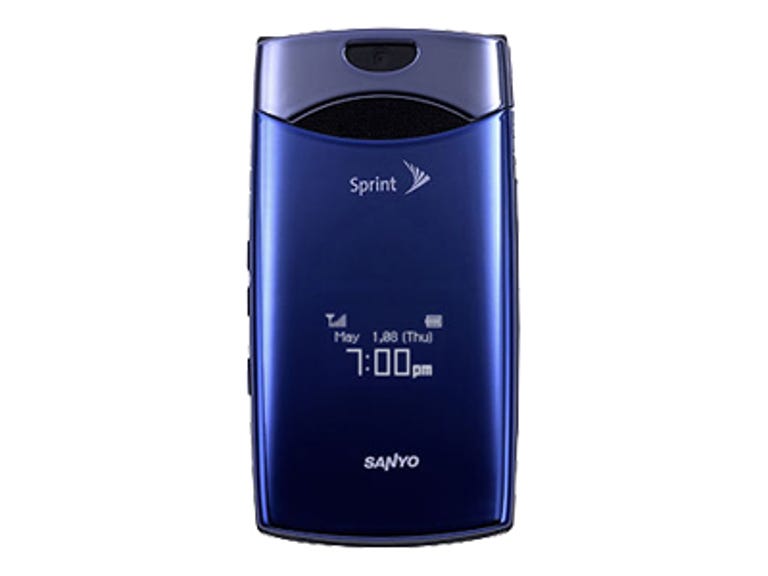Sanyo and Sprint launched two Katana flip phones a year ago, dubbed the Katana DLX and the Katana II. Both handsets followed the first Sanyo Katana released about two years ago, which was nothing more than a scaled-down Razr competitor. The Katana DLX saw a number of impressive feature upgrades, but the Katana II only saw slight design improvements. Well, the Katana II is now replaced with the Sanyo Katana LX, which debuted for Sprint in April 2008. The Katana LX looks very different from any of the other Katanas, complete with a reflective surface and translucent OLED display. Features include a VGA camera, Bluetooth, GPS location services, and not much else, so this is meant as an entry-level camera phone for those who don't need a lot of fancy multimedia features. The Katana LX comes in Pacific Blue, Elegant Pink, and Liquid Graphite. It's also very affordable at $49.99 after a two-year service agreement with Sprint.
The Good
The Bad
The Bottom Line
Design
If you were to tell us the Katana LX followed the line of the previous Katanas, we wouldn't have believed you, based on its design. While the other Katanas opted for the slim and wide Razr look, the Katana LX is completely different. Measuring 3.7 inches long by 1.9 inches wide by 0.7 inch thick, the Katana LX is thicker, curvier, with rounded edges and a smooth reflective front surface. The surface is so reflective you could use it as a mirror. It's not too heavy at 3.4 ounces and has a nice heft in the hand.

At first glance, you might think the Katana LX doesn't have an external screen. But when you hit any button along the side, you will activate a very cool translucent OLED display. It is right in the middle of the phone and displays the usual date, time, battery, and signal strength information. Because of the translucent display, the letters and numbers appear to be floating in the middle of the phone, resulting in a modern space-age sort of look. Since it is OLED, however, you can't view photo caller ID. It also won't act as a camera viewfinder, but the surface of the phone is reflective enough to be used as a self-portrait mirror. Above the display is the speaker grille, and above that is the camera lens. A dedicated camera button, volume rocker, and charger jack sit on the left spine.
Flip open the phone and you'll find a 65,000-color internal display. It's a tad smaller than the Katana II at around 2 inches diagonally. Not only does the screen appear lackluster, its menu interface lacked color as well. You can adjust the display's backlight time, font size, and contrast. You can also change the foreground with a clock/calendar or greeting.
Underneath the display is the navigation array, arranged in almost a half circle. They consist of two soft keys, a dedicated camera key, a Back button, plus a four-way circular toggle with a middle Menu/OK key. The toggle can be mapped to four user-defined shortcuts. The Talk key, speakerphone/voice command key, and End/Power key are underneath the toggle. We weren't fans of the keypad--the keys are somewhat flush to the surface of the phone and feel a bit slippery as well.
Features
As an entry-level camera phone, we weren't expecting much from the Katana LX, and indeed it has almost identical features to the Katana II. Starting with the basics, it comes with a 600-entry contacts list and each entry can hold up to seven numbers, two e-mail addresses, a URL address, and a memo. You can organize contacts in caller groups, pair them with a photo for caller ID, or any of 32 polyphonic ringtones. Bear in mind the photo caller ID only shows up on the internal display, so it's probably not as useful. Other essentials include vibrate mode, speakerphone, text and multimedia messaging, a calendar, an alarm clock, a countdown clock, a stop watch, a world clock, and a calculator. More advanced users will appreciate e-mail, instant messaging, Bluetooth, voice dialing, voice recording, a wireless Web browser, and GPS functionality. The latter can only be used if you have a data plan and sign up for Sprint Navigation.

The Katana LX only comes with a VGA camera, which is understandable for a phone at this price range. You can take pictures in three resolutions (640x480, 320x240, and 160x120), three quality settings, and five picture modes (Normal, Beach/Snow, Scenery, Night/Dark, Soft Focus). Other settings include brightness, white balance, a self-timer, multishot, fun frames, color tone, zoom, and shutter sounds (three sounds plus a silent option). Photo quality was pretty disappointing, as to be expected. Images looked blurry and overcast. There's no built-in camcorder.
You can customize the Katana LX with a variety of graphics and alert tones for wallpaper, screensavers, and so forth. The Katana LX comes with a couple of Web applications--InStyle Magazine Demo and MSN Live Search--but you can always get more. On the gaming front, the phone comes with demo versions of Sims 2, Madden NFL 08, Midnight Pool, Pac-Man/Ms. Pac-Man, Tetris, and WSOP Pro Challenge Poker. As always you can download more from the Sprint store.
Performance
We tested the dual-band (CDMA 800/1900) Sanyo Katana LX in San Francisco using Sprint's service. We enjoyed full signal strength in most parts of the city, and call quality was very impressive as well. Callers often thought we were on a landline, thanks to the lack of static and background noise. Speakerphone quality did not fare as well--we thought our callers sounded rather tinny, while they thought we needed to speak up a bit. We managed to pair the Sanyo Katana LX with the Plantronics Discovery 925.
The Sanyo Katana LX has a rated talk time of talk time of 4.8 hours, and a tested talk time of 5 hours and 16 minutes. According to FCC radiation tests, the Sanyo Katana LX has a digital SAR rating of 0.783 watt per kilogram.



